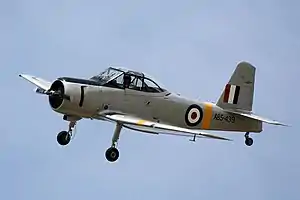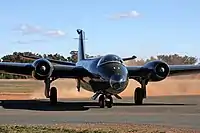No. 100 Squadron RAAF
No. 100 Squadron is a Royal Australian Air Force (RAAF) historic aircraft display squadron. It was originally formed as a bomber and maritime patrol squadron that operated during World War II. Raised in early 1942 from the remnants of a British unit that had been destroyed in Malaya, the squadron flew Bristol Beauforts from bases in Queensland and New Guinea, undertaking torpedo- and level-bombing sorties against Japanese targets in the Pacific theatre. Following the conclusion of hostilities, the squadron was disbanded in August 1946. It was reformed as the Air Force Heritage Squadron in January 2021 to operate airworthy warbirds.
| No. 100 Squadron RAAF | |
|---|---|
.jpg.webp) Four No. 100 Squadron Beauforts near the New Guinea coastline in 1945 | |
| Active | 1942–1946 2021–current |
| Country | Australia |
| Branch | Royal Australian Air Force |
| Role | Bomber (1942–1946) Historic aircraft display (2021–current) |
| Part of | No. 9 Operational Group RAAF (World War II) Air Force Training Group (current) |
| Current base | RAAF Base Point Cook |
| Motto(s) | Then, Now, Always (2021–current) |
| Engagements | World War II |
| Commanders | |
| Notable commanders | John Balmer (1942–1943) |
| Aircraft flown | |
| Bomber | Bristol Beaufort (1942–1946) |
History
World War II
No. 100 Squadron was formed at RAAF Station Richmond, New South Wales, on 15 February 1942;[1] the following month Wing Commander John Balmer took command of the squadron.[2] The squadron was formed from a nucleus of No. 100 Squadron RAF, which had been destroyed during the Malayan Campaign, and was named in that unit's honour.[1] Despite this link, No. 100 Squadron RAAF was an Australian squadron throughout its existence and considered to be separate from its British namesake, which was re-formed as a heavy bomber squadron in Britain on 15 December 1942.[3][4] The unit subsequently moved to Mareeba, Queensland, in May 1942, before conducting further training and anti-submarine patrols.[5]
Staging through Port Moresby, No. 100 Squadron flew its first combat missions in June 1942, making it the first of the RAAF's Beaufort bomber-equipped squadrons to see combat.[1] During the mission seven aircraft bombed targets around Lae, losing one aircraft whilst sinking a Japanese merchant ship. Later a number of successful attacks were completed against Japanese positions.[5] Following these attacks the squadron was withdrawn to Laverton in July, subsequently conducting patrols off New South Wales and Victoria and undertaking further training.[6] A further move was later undertaken to Bohle River in Queensland.[5] Meanwhile, after completing its training the squadron commenced deploying to Milne Bay in New Guinea in September 1942.[1][7]

In October 1942, while participating in a training exercise off the coast of Townsville, Beaufort A9-26 of the No. 100 Squadron struck the mast of the wrecked SS City of Adelaide in Cockle Bay, Magnetic Island. The aircraft plunged into the shallow water below and the fuselage disintegrated on impact killing three RAAF officers and one US Navy officer aboard.[8] On 6 October 1942 the Squadron conducted its first torpedo strike, with six Beauforts unsuccessfully targeting Japanese naval vessels.[5] Over the following months the squadron conducted a number of dangerous low-level attacks with limited success, although a number of Japanese vessels were damaged or sunk.[5] On 9 January 1943 a convoy returning from Lae was intercepted by six Beauforts off Gasmata. A Japanese cruiser was believed sunk in the action, for the loss of two aircraft.[9][5]
Flying from bases in eastern New Guinea No. 100 Squadron flew reconnaissance patrols and anti-shipping and bombing missions against the Japanese in the Solomon Islands and New Guinea mainland.[1] Eight aircraft from the squadron participated in the Battle of the Bismarck Sea, during which the squadron conducted a torpedo-bombing mission. It was not successful in sinking any ships in this battle, though, and from March 1943 it operated solely in the level bombing role.[1] Later, in September 1943, the squadron flew anti-submarine patrols in support of amphibious landings around Lae.[10] On 4 October, ten Beauforts made a low-level attack on the Japanese airfield at Gasmata, with three aircraft being shot down.[5] A surfaced submarine was attacked and heavily damaged in St George's Channel on 18 October.[11] The squadron bombed a bridge over the Anwek River in November as part of an air offensive over New Britain and the same month moved to Goodenough Island.[12]
The squadron remained at Goodenough Island until April 1944, when it relocated to Nadzab. This was followed by a further move to Tadji in July 1944.[13] As a level bomber squadron, No. 100 Squadron conducted missions against Japanese facilities throughout New Guinea and surrounding islands during 1944, including the key base at Rabaul.[14] In late 1944 and into 1945, it conducted operations in support of Allied ground operations. In October 1944, a detachment of five aircraft and crews from No. 100 Squadron being sent to reinforce No. 6 Squadron, which had been tasked to support Australian landings on New Britain. Prior to the landings, the Beauforts attacked targets across the Gazelle Peninsula, and then remained on standby to support the Landing at Jacquinot Bay. Later, further operations were flown around Wide Bay.[15] The squadron's attention then turned to support of the 6th Division's campaign in Aitape–Wewak.[16] The squadron continued in this role until the last day of the war, flying its final bombing mission the morning Japan surrendered, on 15 August 1945.[17]
Following the end of hostilities, No. 100 Squadron flew reconnaissance missions and leaflet drops before transferring to Finschafen in March 1946.[18] There it undertook ferrying and courier flights until disbanding on 19 August 1946;[17] prior to this, the squadron's strength had dwindled as personnel were repatriated back to Australia for demobilisation or transferred to other units for subsequent service with the occupation forces in Japan.[19] Throughout the war a total of 115 aircrew fatalities were recorded among the squadron's personnel as a result of combat operations.[20]
Air Force Heritage Squadron
On 1 January 2021, the RAAF reformed No.100 Squadron as the Air Force Heritage Squadron, under the Air Force Training Group, to operate the heritage aircraft as airworthy warbirds. It comprises the Point Cook Heritage Flight at RAAF Base Point Cook and the Temora Historic Flight at Temora Aviation Museum.[21][22]
Ownership of 12 historically significant aircraft was transferred from the Temora Aviation Museum to the RAAF in July 2019 and operated by the RAAF as the Temora Historic Flight. They are maintained by museum staff and pilots are inducted into the RAAF Reserve.[23][24]
Current aircraft
All are airworthy except as noted.
| Aircraft | Civil registration | RAAF serial | Image | Notes |
|---|---|---|---|---|
| Point Cook Heritage Flight | ||||
| CAC CA-18 Mustang Mk.23 | VH-SVU | A68-170 |  | |
| PAC CT/4A | VH-NZP | A19-077 | .jpg.webp) | |
| North American AT-6D | VH-HVD | NZ1075 | ||
| Royal Aircraft Factory R.E.8 | VH-OTF | 0003 | Replica | |
| CAC Winjeel | VH-FTS | A85-439 |  | |
| de Havilland Tiger Moth | VH-AWA | A17-692 | _JP5845471.jpg.webp) | |
| Sopwith Pup | VH-PSP | %252C_RAAF_Museum_AN1041159.jpg.webp) | Replica | |
| Sopwith Snipe | VH-SNP | E8050 | Replica | |
| Curtiss P-40E Kittyhawk | A29-90 | Under restoration | ||
| Temora Historic Flight | ||||
| English Electric Canberra TT18 | VH-ZSQ |  | ||
| Lockheed Hudson Mk III | VH-KOY | _Lockheed_Hudson_Mk_III_taking_off_at_the_2019_Australian_International_Airshow_(1).jpg.webp) | ||
| Cessna A-37 Dragonfly | VH-XVA | _AN0527172.jpg.webp) | ||
| Supermarine Spitfire Mk.VIII | VH-HET | .jpg.webp) | ||
| Supermarine Spitfire Mk.XVI | VH-XVI | _Supermarine_Spitfire_Mk_XVI_taxiing_at_the_2019_Australian_International_Airshow.jpg.webp) | ||
| Gloster Meteor F8 | VH-MBX | A79-851 | .jpg.webp) | |
| de Havilland Vampire T.35 | VH-VAM | A79-617 | _AN1096500.jpg.webp) | |
| CAC Sabre | VH-IPN | A94-983 | _CAC_Sabre_Mk.32_landing_at_Avalon_during_the_2015_Australian_International_Airshow.jpg.webp) | |
| CAC Wirraway Mk 3 | VH-BFF | A20-653 |  | |
| CAC Boomerang | VH-MHR | A46-122 | _Commonwealth_Aircraft_Corporation_CA-13_Boomerang_taking_off_at_the_2019_Australian_International_Airshow.jpg.webp) | |
| de Havilland Tiger Moth | VH-UVZ | A17-691 | _de_Havilland_DH-82A_Tiger_Moth_during_the_2015_Warbirds_Downunder_Airshow_at_Temora_(1).jpg.webp) | |
| Ryan STM | VH-RSY | _Ryan_ST-M_S2_during_the_2015_Warbirds_Downunder_Airshow_at_Temora.jpg.webp) | ||
References
- Citations
- "No. 100 Squadron RAAF". RAAF Museum. Retrieved 17 November 2014.
- Gillison 1962, pp. 552–553.
- "100 Squadron RAF". Royal Air Force. Archived from the original on 25 February 2013. Retrieved 17 November 2014.
- "No. 100 Squadron". Flight: 673–676, 678. 28 October 1955.
- Eather 1995, p. 101.
- RAAF Historical Section 1995, p. 100.
- Odgers 1968, p. 23.
- King 2008, p. 63.
- Barnes 2000, p. 235.
- Odgers 1968, p. 73.
- Barnes 2000, p. 236.
- Odgers 1968, p. 123.
- King 2008, pp. 149, 170.
- Odgers 1968, p. 329.
- King 2008, pp. 198–200.
- Odgers 1968, pp. 330, 337.
- RAAF Historical Section 1995, p. 102.
- King 2008, p. 265.
- King 2008, p. 264.
- King 2008, p. 257.
- "RAAF reforms legendary 100 Squadron to fly warbirds". Australian Aviation. 9 February 2021. Retrieved 9 February 2021.
- Thorn, Adam (15 February 2021). "RAAF's reformed 100 Squadron appoints commanding officer". Australian Aviation. Retrieved 21 April 2021.
- "May 2019 News". Temora Aviation Museum. Retrieved 13 January 2020.
- "Squadron keeps history alive". Defence News. 11 February 2021.
- Bibliography
- Barnes, Norman (2000). The RAAF and the Flying Squadrons. St Leonards, New South Wales: Allen and Unwin. ISBN 1-86508-130-2.
- Eather, Steve (1995). Flying Squadrons of the Australian Defence Force. Weston Creek, Australian Capital Territory: Aerospace Publications. ISBN 1-875671-15-3.
- Gillison, Douglas (1962). Royal Australian Air Force 1939–1942. Australia in the War of 1939–1945. Series 3 – Air. Vol. 1. Canberra: Australian War Memorial. OCLC 2000369.
- King, Colin (2008). Song of the Beauforts: No 100 Squadron RAAF and Beaufort Bomber Operations. Tuggeranong, Australian Capital Territory: Air Power Development Centre. ISBN 9781920800246.
- Odgers, George (1968) [1957]. Air War Against Japan 1943–1945. Australia in the War of 1939–1945. Series 3 – Air. Vol. 2 (reprint ed.). Canberra: Australian War Memorial. OCLC 246580191.
- RAAF Historical Section (1995). Units of the Royal Australian Air Force – Volume 3: Bomber Units. Canberra: Australian Government Publishing Service. ISBN 0-644-42795-7.